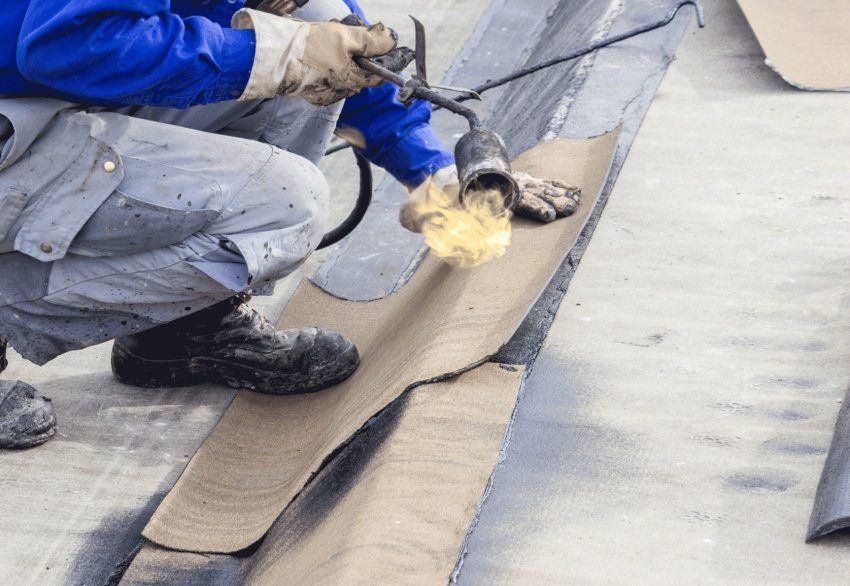Construction oil bitumens, roofing (GOST) is a tar-like mineral-organic substance, which contains hydrocarbon elements, as well as oxygen nitrogen and metal-containing compounds. There are several types of bitumen that are present in the natural environment (in liquid form in petroleum, in solid form in resin and asphalt). Bitumen can be dissolved in substances of organic origin, such as benzene or carbon disulfide. Water has no effect on him and causes only a repulsive reaction.

Processing of bitumen raw materials
Bitumen is mined by well, mining or quarry. Oil products in solid, liquid or viscous state are widely used in construction. Bitumens are produced oil – construction, roofing, road, waterproofing. Also resinous substances are used in chemical and paint and varnish production.

Helpful advice! The main indicators that determine the scope of application of bitumen in the solid state are the criteria for viscosity, plasticity, amorphism and fragility. For liquids – viscosity and fraction of volatile oils.
The main type of raw material from which construction oil and roofing bitumens are produced is oil. After fractional distillation and separation of light substances from its composition, such as gasoline, naphtha, kerosene, lubricants, and other by-products derived from petroleum, the basis of bituminous material is obtained from heavy residues. The amount of product depends on the qualitative composition of the oil, which has different consistencies. The modern method of producing bitumen is based on atmospheric separation and vacuum distillation, followed by oxidation or mixing of solid residues.
The oxidation process consists in purging the oil refining residues to obtain a product of a certain viscosity level. Oxygen, interacting with tar, promotes the oxidation of bitumen and the formation of high molecular weight components in it. This technology allows you to get a quality product. From it are produced roofing oil bitumens, which GOST, designed specifically for this material.

The second method of manufacture, which is produced after distillation – mixing. After it, compounded materials are obtained. The essence of this process lies in the fact that the tar substance is treated with propane in liquid form and mixed with oil distillates.
Plasticity index depends on the content of oily substances, duration of exposure to mechanical loads and temperature. In oil roofing bitumen, GOST in terms of ductility is determined by the ability of a material to stretch into a thin thread on a device called a ductylometer. The test is carried out at a temperature of zero and 25 ° C temperature. The length of the thread at the moment of rupture is an indicator of the plasticity of bitumen.
Viscosity of matter reflects the structural and mechanical basis of the material. This characteristic is a reflection of the composition and the reaction to a certain temperature. At low temperatures, the viscosity index increases, and at high temperatures it decreases. Roofing oil for bitumens, GOST method of testing solid and viscous substances, checked with a needle.

Its penetration into the material at a certain load, temperature and time of immersion is fixed by a pentameter. The smaller the depth of penetration, the higher this figure. The viscosity of liquid materials is determined using a viscometer when the test substance flows through the opening of the device for a certain period of time.
Softening temperature determined on the device “ball and ring”. The principle of the study is that the bitumen sample is placed on a brass round hole of a certain diameter and is gradually heated under the uniform pressure of a metal ball until it touches the bottom bar of the device. The standard softening temperature ranges from 20 to 95 ° C.
An additional characteristic of the heat resistance of the bitumen material is the brittleness temperature. This indicator is determined by the moment of appearance of the first crack on the material during simultaneous bending and cooling of the material under study.

Flash point. When bitumen is heated, vapors are formed which, in contact with open flame, ignite. In the course of research on a special device, the moment of ignition of vapors describes the degree of its fire hazard. The usual rate of heating up to the moment of ignition for solid or viscous substances is below the 200 ° C indicator.
Many technologies have been developed to determine the adhesive properties, as well as devices. The most accessible is the visual method. To test does not require complex devices.
Helpful advice! An important feature of bituminous materials is their property to adhere to any surfaces of mineral or organic origin.
Bitumen is glued to the surface of the gravel, and then boiled in water. If, after the completion of the experiment, the film remains in the same position, the indicator is rated the highest on a five-point scale. An unsatisfactory assessment of adhesiveness is made in the event that the film does not hold on the object at all in the process of boiling.

Obtaining the results of research on viscosity, plasticity, softening temperature allows you to determine the brand of products that are characterized by the state standards as follows.
Roofing materials for the roof: types and prices of modern coatings. Varieties of coatings. Comparative characteristics, disadvantages and advantages. Classification of materials for the construction of roofs.
GOST are divided into three types, which are designated as BN. The abbreviation “BN” means “oil bitumen”. The numbers follow it – this is the softening temperature and the average value of the limits of needle penetration.
| Name of the indicator | Brand rate | Test method | ||
| Bn 50/50 | Bn 70/30 | Bn 90/10 | ||
| OKP 02 5624 | OKP 02 5623 | OKP 02 5622 | ||
| The depth of penetration of the needle at 25 ° C, 0.1 mm | 41-60 | 21-40 | 5-20 | According to GOST 11501-78 |
| The softening temperature of the ring and the ball, ° C | 50-60 | 70-80 | 90-105 | According to GOST 11506-73 |
| Extensibility at 25 ° С, not less | 40 | 3.0 | 1.0 | According to GOST 11505-75 |
| Solubility,%, not less | 99.5 | According to GOST 20739-75 | ||
| Mass change after heating,%; no more | 0.5 | According to GOST 18180-72 | ||
| Flash point, ° С, not lower | 230 | 240 | According to GOST 4333-87 | |
| Water content | Traces | According to GOST 2477-65 | ||
GOST are developed in modifications BNK. “BNK” is a roofing oil bitumen. The softening and viscosity values are determined and assigned in the same way.
| Name of the indicator | Brand rate | Test method | ||
| BNK 40/180 | BNK 45/190 | BNK 90/30 | ||
| The depth of penetration of the needle, 0.1 mm at 25 ° C | 160-210 | 160-220 | 25-35 | GOST 11501 |
| Softening temperature, ring and ball, ° C | 37-44 | 40-50 | 80-95 | GOST 11506 |
| Brittleness temperature, ° С, not higher | – | -ten | GOST 11507 | |
| Solubility in toluene or chloroform,%, not less | 99.5 | GOST 20739 | ||
| Mass change after warming up,%, not more | 0.8 | 80.0 | 0.5 | GOST 18180 |
| The depth of penetration of the needle in the residue after heating,% of the initial value, not less | 60 | 70 | GOST 11501 | |
| Flash point, ° С, not lower | 240 | GOST 4333 | ||
| Mass fraction of water,%, not more than | Traces | GOST 2477 | ||
| Mass fraction of paraffin,%, not more than | – | 5.0 | – | GOST 17789 |
| Penetration index | from 1.0 to 2.5 | – | GOST 954 | |
In addition to substances of solid and viscous consistency, there are bitumen materials that are in a liquid state. At normal room temperature, they have a low viscosity index. For construction purposes, they are used in a cooled or relatively heated state.
As a material for construction, bitumen is endowed with excellent adhesion and water repellency. Its use allows you to create reliable durable roofing, communications, waterproofing foundations and other types of structures. In order to correctly determine the purpose of a particular type of bitumen, it is important to get acquainted with its qualitative and component characteristics. Numerical indicators allow you to properly select and use bitumen for its intended purpose, because bitumen can be building, road or for roofs.
In addition, bitumen can be used for other purposes. On its basis, super-strength sealants are produced, which are used to seal seams on airfield fields and runways. Industrial and civil construction does not do without bitumen, since mastics, which contain polymer-bitumen ingredients, are used for finishing insulation works.

This material is best suited for strengthening and waterproofing openings in structures. Rubber-bitumen materials are used to cover the mastic roofing of the rollless type. Bitumen of petroleum origin is indispensable for most types of roofing work.
Helpful advice! It is important to note, that the durability of the bitumen coating depends on the proper use of the material. Its brand and GOST must comply with the objectives of the application in each case.
For example, road bitumen cannot fully replace roofing or construction, or vice versa. Users always need to pay attention to this, despite the fact that visually bitumen of different grades is almost identical.
Construction oil bitumens, roofing (GOST) practically have no shelf life, so they can serve for a very long time, providing reliable protection and compaction of building structures. Also, bitumen surfaces can be easily, easily and inexpensively updated and repaired.

